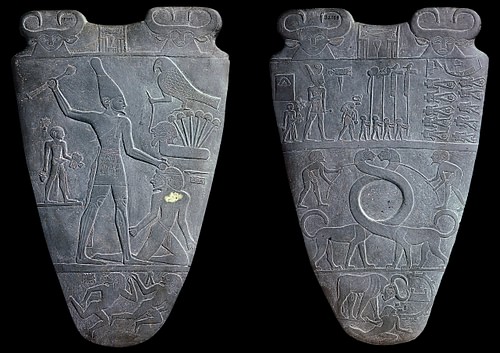Lecture Summary
This week’ lecture focused on the evolution of art and typeface, and the circumstances affected their creation.However we did stray a little from the initial subject of art and typeface, delving into more historical aspects of these subjects, such as the circumstances which allowed for them to arise. This sort of discussion turned out to be very helpful for my group and myself who are in the geo-political group. In many cases, language was advanced not only be trade, but by direct commands from the government. Examples of this include the Chinese folktale which states that the yellow Emperor ordered Kanji, to create a writing system and the Korean king Sejong ordered the creation of the Hangul alphabet. From this we began to think about how leaders can be on of the driving force in the development of concepts such as writing. Both examples mentioned are still the current writing systems of their respective countries. Our plan for our spread was to look at the Ancient Egyptian concept of kingship, as well as the influential rulers and their effect of Egypt as a whole, and this lecture helped us brainstorm more
Research (300-500)
Egyptian Concept of Kingship
The pharaoh was the political and religious ruler of Egypt, and often acted as a representative of the gods. The word pharaoh is a great variant of the Egyptian “pero” or “per-a-a”, which can be translated as “Great House. While Egypt was divided into sections called Nomes and ruled by Nomarchs, in the end, the Pharaoh has power over all. Similar to every other aspect of egyptian theology, the concept of duality is integral to the Egyptian concept of kinship. The pharaoh was both a political symbol and a theological concept. For example, in texts Pharaohs are often referred to by the gods as “my living image on earth” and are depicted with many similarities to Re, Aton, Amon and especially Horus. The pharaoh is even referred to as Aton, Horus, and Re. However, it is important to note that the pharaoh himself is not a god. Even though divinity is intertwined with the role of the Pharaoh, the pharaoh is not divine himself. The king can still physically die, but his soul is immortal. Simply put, the Pharaoh can be thought of a version of Horus, not the Horus. The pharaoh’s divine role was often represented in art. In ancient Egypt, the relative sizes of people and deities was indicative of their status, and pharaohs were always depicted as least as large as other humans. Additionally, humans were often shown bowing in reverence to pharaohs.
A pharaoh’s goal was not only to to be religious and political leader of egypt but also to uphold Ma’at. Ma’at refers the Egyptian ideas of justice, balance and harmony, as well as its divine personification the goddess Ma’at.The pharaoh was meant to follow the wishes of Ma’at and to follow through with them.
The first reference to an Egyptian pharaoh is the legend of Menes, who was said to be the uniter of Lower and Upper Egypt. This feat was accomplished through conquest, and thus the first dynasty of Egypt was founded and of the city Memphis. Unfortunately, archaeologist’s search for evidence of his evidence has largely turned out to be fruitless. Many Egyptologist, such as Flinders Petrie believe that Menes was a reference to a title instead of a name (meaning “he who endures”). However much evidence has been found to corroborate that Narmer (c.3150 BCE) was most likely the first pharaoh.
Perhaps the most promising evidence is the Narmer Palette, which depicts Narmer symbolically unifying Egypt. Narmer is always depicted wearing a combination of the two crowns of Egypt. The red crown is representative of lower Egypt, while the white crown of Upper Egypt. Thus, the combined version visually depicts the coalescence of Egypt. Many Egyptian documents after the unification of Egypt portray pharaohs wearing this crown. However, interestingly enough archeologist have been unable to find any physical proof of these crowns.




There is a pretty large disconnect between the mythical figure of Menes and more evidence based story of Narmer.For example, the legend of Menes states that Lower and Upper Egypt were unified through conquest. However, Narmer’s story states that unification of Egypt was bloodless. Unlike Menes, Narmer supposedly accomplished this feat by marrying a princes, consolidating power and through forging strong connections with neighbouring factions.
Notable Pharaohs
Pepi II or otherwise known by his Pharoah name Neferkare (meaning “Beautiful is the spirit of Ra”), was the 5th Pharaoh of the 6th Dynasty (2325-c.2150 BCE), and is credited for having the longest reign of any pharaoh. Sources say that he ascended to the throne at age six and records Credit him with a reign of 94 years. However it should be noted that while Pepi II enjoyed the longest reign of them all, it was not a prosperous time. On the contrary it was a characterized by the internal and external strige which Egypt faced. Pepi II’s reign was characterized by the decline of the Old Kingdom, in large part due to changing dynamics of powers. Internally, Nomarches (nobles who ruled over the the divided sections of Egypt called Nomes” were enjoying an increase of power from the previous ruler, Pepi I. Consequently, small civil wars broke out as a result from their struggles for power. Additionally, Egypt suffered low flooding from the Nile, which had disastrous consequences. Pepi’s solution of taxing the poor in order to make up for the costs had the opposite intended effect, only hurting his already diminishing reign. In the end, Pepi’s death marked the end of of the 6th dynasty of Egypt and the splendor of the Old Kingdom.
Ramses II, more commonly known as Ramses the Great or by his pharaoh name Userma’atre’setepenre (“keeper of Harmony, Strong in Right, Elect of Ra”) is remembered as one of the most successful pharaohs. He was the 3rd pharaoh of the 19th dynasty (1292-1186 bCE). His most notable accomplish was the victory at Kadesh against Hittite invasion , where he established a reputation as a warrior. He boasted a long and prosperous reign in which he gained trading partners, secured borders, augmented the country’s wealth, and built a truly astonishing about of monuments and temples and statues of himself (more than any other pharaoh). He was considered so successful and loved that his legacy was a string of Pharaohs named in his honour.
Sources
Mark, Joshua J. “Ramesses II.” Ancient History Encyclopedia. Ancient History Encyclopedia, 02 Sep 2009. Web. 21 Sep 2018.
Mark, Joshua J. “Pharaoh.” Ancient History Encyclopedia. Ancient History Encyclopedia, 02 Sep 2009. Web. 21 Sep 2018.
Mark, Joshua J. “Menes.” Ancient History Encyclopedia. Ancient History Encyclopedia, 29 Jan 2016. Web. 21 Sep 2018.
“Pepi II King of Egypt.” Britannica, www.britannica.com/biography/Pepi-II.
Accessed 21 Sept. 2018.
Photos
Narmer Palette- https://www.ancient.eu/Menes/
All pictures of the crowns -https://en.wikipedia.org/wiki/Crowns_of_Egypt